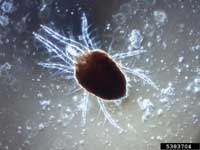|
Identification:
The Red Palm Mite has not been detected in Hawaii. However, it has invaded the Western Hemisphere including the Caribbean, Florida and other states on the mainland. These reddish mites are easily seen against the green color of leaves and fronds. Adult mites are around 1/100th of an inch with flattened red bodies and red legs and have bristle-like setae, or hairs, on their back which produce droplets at their tips. Heavy infestations are usually seen on the underside of leaves.
Impacts: This mite is a serious pest of the coconut palm, date palm, other palm species, as well as bananas, beans, and durian. The leaves of infested plants will exhibit yellow spots and blotches from the mites' feeding damage. The yellowing can become so severe that entire fronds will turn yellow and eventually brown. They may be mistaken for the red spider mite, but unlike the spider mite the Red Palm Mite does not produce webbing.
Dispersal Mechanism: This mite is easily distributed by wind currents, the movement of plants and the infested parts of plants. It is expected to establish in other subtropical regions of the Western Hemisphere. If you see this mite anywhere in Hawaii- let someone know! If you are in doubt, send a picture to the reporting page and we will help you identify it.
More information about this pest 
|
|
|
Red Spider Mite (Tetranychidae spp.):
Red spider mites are also found in Hawaii. Spider mites do not have flattened bodies, do not produce droplets on their back, do not have red legs, and will produce spider-like webbing. The gorse red two-spotted spider mite (Tetranychus telarius) was introduced to Hawaii as a natural enemy of the invasive gorse (Ulex europaeus) plant.
|

|
|
Gorse red two-spotted spider mite (Tetranychus telarius)
Images: left, Forest & Kim Starr; above, Charles Olsen, USDA APHIS PPQ, Bugwood.org
|
|